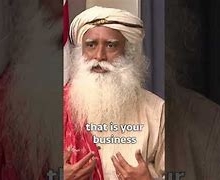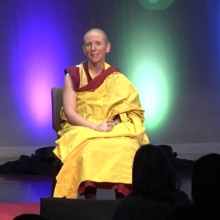How drawing helps you think | Ralph Ammer | TEDxTUM
Translator: Rosa Baranda Reviewer: Peter van de Ven Whenever we draw something, we ask ourselves painful questions, such as, ‘Is this drawing good?’ ‘Am I talented?’ or worst of all, ‘Is this art?’ And that leads many of us to say, ‘Well, this doesn’t look like art. I’m not an artist anyway. I can’t draw, and I shouldn’t do it.’ We would never do that with language. No one would say, ‘Well, this just didn’t come out like a poem. I shouldn’t speak.’ (Laughter) Because we know language is a way to think and get in touch with others. Well, and so is drawing.
00:00:55
We’ve put drawing into this dark corner of the art world. But drawing is not only about artistic excellence, personal self-expression, or talent for that matter. Drawing is not about art.
00:01:12
Drawing is bigger than art.
00:01:14
It is a way to think in pictures – like an architect does when she tries to imagine a new building, or a scientist who tries to figure out the spatial structure of molecules. These people are not only thinking in words; they are also thinking in pictures.
00:01:34
The think visually. You can do that too.
00:01:38
And today I want to show you five ways how drawing can support your visual thinking. Let’s get to the first one, intuition.
00:01:48
When we want to get better at drawing, the first thing we might want to do is improve the connection between our hands and our eyes. And we can do that with little exercises like this one, where we just fill a piece of paper with circles.
00:02:06
We start with bigger ones and gradually fill up the whole space. And exercises like these are physical workouts for our hands. So they might get a little tense now and then, but the stronger our hands become, the better we can control them to draw.
00:02:28
Repetitive exercises like these also have a soothing effect on our minds. We have to focus intentionally on our visual sense.
00:02:39
So they bore other parts of our thinking, bore them in the best sense of the word.
00:02:47
They bore our restless thoughts and worries and make room for a more intuitive visual mindset. And in this intuitive mindset, we can see beautiful things. Because, you know, seeing beauty is not that easy. The problem is there are just too many things. We can’t see everything – it would be too exhausting – so we have to reduce the amount of information that we take in, and we try to see patterns and order. We also see less.
00:03:31
Now, without turning around, ask yourselves, What is the person behind you wearing? How many trees did you see in front of this building when you came in? We don’t pay attention to these things, because we don’t have to.
00:03:50
It’s much easier to just recognize things around us instead of actually looking. We don’t care how many leaves are on a tree or how its branches are shaped, (Laughter) all we need to do is identify the tree so we don’t run into it. We reduce the world to labels. But when we draw, we actually have to look and discover the world around us.
00:04:18
The labels disappear, and we see what is actually there, right now. We situate ourselves in the world.
00:04:29
And because we pay such intense attention to what is around us, it becomes a part of us.
00:04:37
So when I think back of this beautiful French small town where I spent last summer, I can remember many beautiful details.
00:04:44
Because I spent the time and the effort to look and draw them. So I stored those memories in my mind and not on my camera. Now, you might say, ‘Okay, I want to discover beautiful things too; I’m going to draw one of those plants.’ And the drawing should look something like this. So you give it a go, but your drawing might turn out more something like that. (Laughter) What’s going on here? The problem is we tend to draw what we already know, and not what we see.
00:05:32
Here is a little trick, how you can switch off what you know. Instead of drawing an object, let’s focus on the spaces between the object and draw those.
00:05:45
Because when there’s nothing to recognize for our rational mind, like the leaves or the buds of the plant, it’s easier for us to actually observe the forms in front of us. And when we make observations like these, we can discover extraordinary beauty in ordinary things. Because we don’t find beauty; we make the world beautiful by paying attention.
00:06:15
Okay, so we know how to get into an intuitive visual mindset and how to draw what we see.
00:06:23
Can we also draw what we cannot see, like our thoughts or emotions? We first have to understand that the way we see the world and, as a consequence, the way how we see images has been shaped by evolution.
00:06:43
Over millions of years, our surroundings have taught us how to perceive the world. Gravity, for instance, is very important for us, so we’re very sensitive to horizontal and vertical lines.
00:06:59
Horizontal lines seem to be stable and resting, like the ground. Vertical lines are in opposition to gravity, as you can see in a standing person or a growing plant.
00:07:13
Both horizontal and vertical lines seem to be relatively stable for us. Diagonals are a whole different story. They make us a little uneasy: ‘Is this thing going to stand up or tip over?’ And it is visual habits like these that are the foundation of our visual language. Now, when I use the term language, I’m using it as a metaphor here. Shapes are very different from words; you can’t look up what a shape means in a dictionary.
00:07:48
And we don’t build sentences, but we build compositions of shapes – compositions that mean something. Here’s something you can try.
00:07:57
Pick any subject, like this ladybug, for instance, and arrange it in different ways on a piece of paper.
00:08:08
Now, observe how the position of the subject changes what the composition says.
00:08:18
Each of these arrangements prompts us to think differently about the ladybug – as a threatening monster, a lover, or maybe someone who got lost. And if you learn compositions like these, if you learn how to use different lines and shapes, then we can draw things that you can’t see.
00:08:40
For instance, I made it a habit to draw my thoughts everyday. In fact I have a rule: if I can’t draw something, then I probably haven’t understood it yet. So I make little sketches, like this one, where I was trying to figure out what’s going on in my mind when I focus on something. Or this one, where I was wondering about the relationship between the shapes of our everyday objects and the shapes of our hands.
00:09:09
This was about two different sorts of conversations that two people can have. And here I was thinking about rhythms and language and other types of communication.
00:09:22
So over time I’ve gathered many, many of these sketches, and they give me an overview of my thoughts about the world.
00:09:30
And I can also rearrange these drawings and see connections. So drawing can also help us to understand.
00:09:42
Okay, so we know how to get into an intuitive mindset, how to discover beauty with drawings, how to draw things that are invisible. What can we do with this? Well, we can imagine something new, something that isn’t there yet. At the core of creativity are ideas. What is an idea? I like to think of ideas as two thoughts or more that we have and that somehow magically combine in our heads and shape something new. And of course, the more thoughts and knowledge we have about what already is, the likelier are the chances that some of those thoughts might combine into something that could be. Creativity really is all about quantity. Let me give you an example.
00:10:40
Let’s assume for a minute that you share my passion for pottery, and you want to come up with a new cup. If you know how to draw things, then you have a visual representation in your mind, and you can combine those, you can work with those.
00:11:02
Let’s say you are into football, and you want to imagine a world cup. You can easily imagine it vividly.
00:11:11
All you have to do now is draw it. Or let’s say you feel a little grumpy today, and you want an angry cup. Or …
00:11:27
you might have a friend who likes things very orderly. You might come up with a very precise cup for her. And this type of visual thinking is very powerful because you can imagine something without having to make it. So, this is very useful in the first part of your creative process, where you try to come up with as many ideas as possible, even the bad ones. Especially the bad ones.
00:12:00
We don’t judge in this part of the creative process. And then in the second part, when we narrow things down to find out a viable solution, a stupid idea from before might turn out as just the right birthday present for a friend.
00:12:18
And you can apply this way of visual thinking to all sorts of problems. Because creativity really is like breathing: you take in information and knowledge, and you combine it to new ideas that you made. And if you know how to draw what you think, then you have a powerful support for this process. You can also share those new ideas with others, in texts or in presentations. Language is probably the most powerful tool we have to communicate, and yet it has its limits.
00:12:59
One problem with written words, for instance, is you have to go through them line by line, word by word to know what they say.
00:13:07
And as soon as you have, those words quickly disappear and vanish into a grey texture again.
00:13:14
It is hard for us to anchor words in our minds, and drawings can help make them stick.
00:13:23
Let’s go back to how we use words as labels. I want you to close your eyes for a second and imagine a tree. Imagine a tree.
00:13:35
Got it? Okay.
00:13:38
Did your tree, or does your tree, look like this? Or like this? Or maybe even like that? Probably not.
00:13:50
I bet each and everyone of you has a different tree in mind right now.
00:13:56
Because the word tree is a public placeholder for all sorts of trees. Now, you could say, ‘Okay, these imaginations, these personal imaginations that we have are different for everyone of us, so they’re useless for communication.
00:14:14
We should focus on the word, the common ground.’ And I would say, ‘If we do that, we’re missing out.’ The problem with words and why it’s so hard to anchor them is it’s hard to relate them to personal experiences.
00:14:31
Now, a drawing can build a bridge between the personal experience of a tree and the abstract expression of it – the word, the conventional word.
00:14:47
And it’s crucial that this drawing is unconventional, specific, and personal.
00:14:54
Let’s have a look at a very conventional illustration of an idea first that keeps haunting flip charts all over the world: the light bulb. I would argue the light bulb is very much on the conventional side. It’s a mere substitute for word.
00:15:16
So it doesn’t add any nutritional value, really.
00:15:21
If, on the other hand, we have a specific personal illustration, then that can supplement what we say with our words.
00:15:33
So if you want to convey an idea with your words, you can help make it stick with an image or a drawing.
00:15:45
And the fact that this drawing is very personal is not a problem; this is actually where its power lies.
00:15:56
Because you can lead other people through your personal expression to connect them and understand your general ideas.
00:16:06
And for that to happen, these drawings have to be as original as our words. Okay, these are just five ways how drawing can support your thinking: it can ignite our intuition, make our lives more beautiful, help us understand, imagine new things, and share them with others. If you make drawing a daily habit, it will be a dramatic improvement for your thinking. And please remember: Our drawings do not have to be pieces of art.
00:16:46
If they help us to think and connect with others, they are good enough. Thank you.
00:16:54
(Applause)















